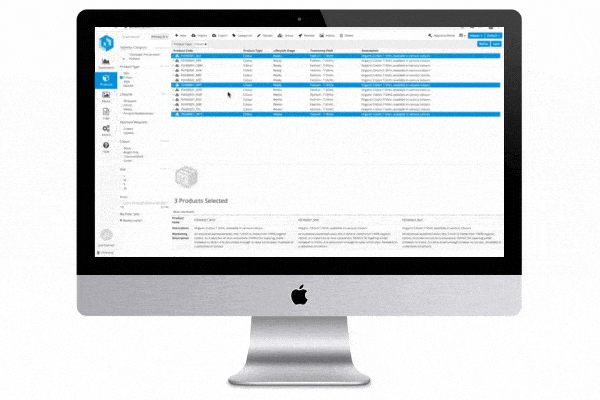There’s a huge audience out there eager to hear about your business’ sustainability. But with so much complex data, how can you ensure customers get the right information at the right time without overwhelming your teams?
You need a powerful and efficient way of managing your data. This is where Pimberly reigns supreme – a souped-up PIM platform loved by some of the biggest retailers around the globe, including JD Sports, Monsoon Accessorize, Regatta, and Ellis Brigham Mountain Sports.
With infinite power, Pimberly can store, optimize, and enrich all the in-depth, granular details around your sustainable products and practices. And as a centralized hub offering full visibility, it drives the productivity of your teams, helping them work smarter and faster.
Learn exactly how Pimberly can help you boost the quality of your data, illuminating your business’ sustainability so you can:
- Tap into a growing market
- Sharpen your competitive edge
- Increase demand for your products
- Boost customer loyalty
- Increase your revenue
All of which will drive your success, strengthening your environmental and social impact in the process.
Below we will cover:
- Powerful data storage and management
- Superior digital asset management
- Maximized product visibility
- A more sustainable way of working
Powerful data storage and management
All of your in-depth sustainability data in one place. Sounds dreamy, huh? Pimberly makes this a reality.
Rapidly import the data around your sustainable products and processes from multiple sources in any form. Then centrally manage this data like a boss, ensuring your products are matched with high-quality information.
Your customers gain the details they need to make informed and conscious buying decisions, driving sales. While each piece of data becomes a crucial chapter in your sustainability story, helping to strengthen your brand image through engaging content.
Supplier and manufacturer data
Pimberly can connect to supplier and manufacturer data feeds in minutes. Store this data, including your digital assets, against the companies you work with. Using Pimberly’s user-friendly dashboard, you gain a clear view of such data, helping you manage it more effectively to create rich backstories that highlight why you’re a sustainable brand.
Remember how sustainability starts at the supply chain? By detailing this information in your product descriptions, or in a separate web page for supplier and manufacturer profiles, you provide substantial evidence around your brand’s sustainability. Reassure customers that what they’re buying has been produced responsibly as you communicate your ethical and sustainable practices.
Clothing components
Savvy sustainability shoppers will go over your materials with a magnifying glass, figuratively speaking. No component will be left unturned. If you want to get a gold star for sustainability, detail everything that goes into your item, including fabrics, dyes, zippers, and buttons. In the process, you’ll gain customers’ trust, driving them to hit “Buy Now.”
Pimberly helps you easily populate and store this information against the right products. Save time as you manage your clothing information more efficiently. You also minimize inaccurate or missing data that could mislead customers and make you lose their trust (and custom!). What’s more, the PIM platform helps you quickly alter your product information – update your clothing components as soon as they change to keep customers informed.
Product care advice
Having helpful, easy-to-understand product care advice on your product pages is a central part of creating a circular economy within your business. It tells customers how to care for their items, ensuring they last for as long as possible. With this information visible, customers will know you’re doing your part to reduce waste and encourage reuse in the fashion industry.
Pimberly makes it easy to store this information against your products. With the right workflows set up, it can also send this content (as well as any other product content) to a proofreading app like Grammarly to determine its readability. Reader-friendly content is an important ranking factor for SEO. It’s also vital for a positive customer experience, especially when it comes to important instructions like product care.
Packaging information
If your products appear sustainable but your packaging doesn’t, alarm bells ring in customers’ heads. They may even accuse you of greenwashing, and nobody wants that! Reassure them you’re a brand they can trust with accurate data about the type of packaging you use. With Pimberly, ensure this data is stored effectively, helping you present it clearly and correctly.
Delivery and returns information
Pimberly helps you easily store your delivery and returns information – essential data to create a satisfying shopping experience. The platform also lets you alter delivery information when needed so you can respond to changes immediately.
Remember, conscious consumers want to see eco-friendly delivery methods. For example, they might want self-service options, such as picking up their package from a local storage unit. If you’re aiming for carbon neutrality, include details on how you’re offsetting your transport emissions.
Keywords around sustainability
Matching your sustainable products with relevant target and longtail keywords is essential for driving product discovery on search engines. Also, conscious consumers will be on the lookout for certain keywords, such as “eco-friendly”, “green”, “ethical”, “living wage”, and (of course) “sustainability” – signals that you’re the right brand for them.
Populate and store an unlimited amount of keywords in Pimberly against your products for different channels, keeping them organized and unlocking their SEO potential. Pimberly also ensures your keywords stay fresh and relevant. Learn more in our white paper: The Ultimate Guide to PIM for eCommerce SEO.18
Personalized product descriptions and categories
Personalize your product descriptions with the ability to store multiple versions. This gives your customers the choice to see as much or as little information as they want, tailoring the shopping experience to their individual preferences.
With Pimberly, you can also create a ‘sustainable’ product category, giving your customers the choice to browse exclusively environmentally-friendly clothing. This is especially useful if you need to accommodate multiple audiences – like the clothing retailer Monsoon – or if you’re in the process of phasing out non-sustainable clothing.
Superior digital asset management
Especially for clothing brands, pictures and videos are an inseparable part of your business. For one thing, they give customers an idea of how your clothes look on a person. Like what they see, and they’ll crave your products, driving them to hit that buy button.
Plus, images such as accreditation logos promoting your business’ fair labor, eco-friendly, and energy-efficient practices are instrumental in helping you build trust with sustainable shoppers. Conscious consumers may even have a list of accreditations to look out for, helping them spot a truly sustainable brand.
Digital assets are crucial for SEO too. Take videos. Search engines consider videos ‘premium content’, placing websites with optimized videos high in search engine results pages (SERPs). Images and videos also encourage customers to spend more time on your product page, which is an important ranking factor.
Keep reading to learn why Pimberly is the ultimate platform for making the most out of your digital assets.
Unlimited storage
You likely have thousands of digital assets, so the ability to store them in one place is critical. Otherwise, your teams will waste precious time searching for and sharing the right image.
Pimberly lets you store unlimited digital assets against one single product! With all your digital assets assigned to the right product, you’ll never lose track of a single image or video.
Remember, one of the most important digital assets for your sustainable business is accreditation logos. Store as many as you need on the page with Pimberly, signalling that you’re a brand sustainable shoppers can trust.
Rich digital content
As well as giving customers a realistic view of your collections, rich digital content helps you tell compelling stories. As a sustainable business, you should have an abundance of inspiring stories to tell, making your brand obsession-worthy.
For example, you could publish pictures and videos of the factories where your products are being made, demonstrating your ethics. Or perhaps your products are created using ancient techniques from incredible artisans – a video featuring an interview and shots of how they work would make customers go crazy for your products!
If you avoid embedding videos into your product pages because it’s too difficult or time-consuming, Pimberly will rock your world. It makes uploading quality videos incredibly easy, encouraging you to use digital assets to enrich your products.
Pimberly also helps your copywriters create better content using images and video. They’re able to see your digital assets in all their glory. This will inspire their content, resulting in compelling product descriptions that emphasize your values, attract conscious consumers, and drive sales.
Easy optimization
Making sure your digital assets are the right size is crucial – especially for mobile. Too big and it will impact your page load speeds – 47% of consumers expect a web page to load within two seconds or less, with 40% abandoning a website that takes more than three seconds to load.19
Pimberly helps to eliminate slow site speeds by automatically resizing your images and videos based on the requirements of your devices and individual sales channels. This improves the customer experience and your ranking – search engines will penalize your site if it takes too long to load.
What’s more, Pimberly automatically renames images according to different sales channel requirements. And the platform constantly refreshes your alt tag (an HTML attribute applied to image tags to deliver written context for search engines) so they’re always up to date, keeping your pages relevant for trending search terms – this is useful as new buzzwords around sustainability pop up all the time!
Maximized product visibility
Conscious consumers are more likely to shop on sustainable marketplaces. To get their attention and custom, your business needs to be visible on places like:
- Accompany
- Made Trade
- Verishop
- Fair Trade Winds
- Two Layer Collective
These marketplaces have one thing in common: strong values around sustainability. That’s why they’re amazing at attracting your target market!
Easily set up sales channels on sustainable marketplaces with Pimberly. This means you can get your products in front of the right people at the right time, maximizing sales.
Pimberly also helps you tailor your product info to meet the unique requirements of each sales channel, thanks to the platform’s advanced scoping functionalities. Ensure your products look perfect no matter where they’re being shown.










